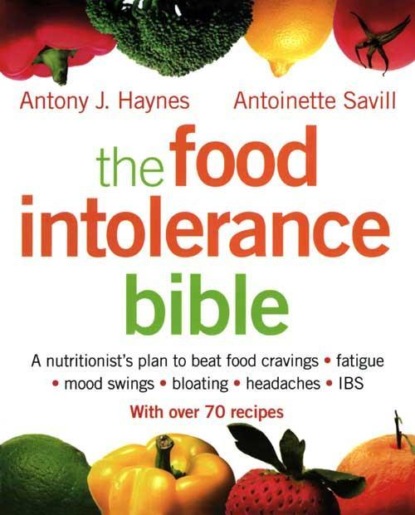По всем вопросам обращайтесь на: info@litportal.ru
(©) 2003-2025.
✖
The Food Intolerance Bible: A nutritionist's plan to beat food cravings, fatigue, mood swings, bloating, headaches and IBS
Автор
Год написания книги
2019
Настройки чтения
Размер шрифта
Высота строк
Поля
IMMUNE REACTIVITY
Your food intolerance reactions are mostly mediated by your immune system, as a result of the delicate interactions between food, your digestive tract, white blood cells and food-specific antibodies called immunoglobulins, as mentioned in the Introduction. There are five types of immunoglobulin: IgA, IgD, IgE, IgG and IgM. The molecules of food to which the body makes antibodies are referred to as antigens. Given that you eat three to four times a day, effectively exposing your body to foreign substances in the process, the food you eat easily represents the single biggest antigenic challenge confronting the human immune system – so perhaps it should not be surprising that your body would make antibodies to foods as often as to any other ‘foreign’ matter it encounters.
HYPERSENSITIVITY
Hypersensitivity reactions have been categorized in various ways, although even this does not always help us when it comes to determining the most appropriate tests that should be done. Nor does this change that fact that you need to avoid the culprit food(s) and address other aspects of your health as necessary. Categorizing reactions is of much more use to scientists and practitioners involved in the field. However, showing you the different categories will help you to understand why symptoms such as yours may have been misunderstood or misdiagnosed in the past. It will also help you to understand why some tests can be wholly inappropriate for you and your symptoms.
These are the classifications for hypersensitivity reactions:
Type I – Immediate IgE reactions
Type II – Cytotoxic antibody-mediated reactions
Type III – Delayed-onset, mainly IgG-mediated reactions
Type IV – Cell-mediated and T Cell-mediated reactions which may also involve IgG reactions
Now let’s take a look at each one in more detail.
Type I – Immediate IgE reactions
These reactions occur within two hours. Food molecules (antigens) bind to IgE antibodies that have already been made in the body, and trigger the release of molecules such as histamine and leukotrienes. It is these substances that cause symptoms – and in this case they are the classic allergy symptoms, such as swollen lips or tongue. Since this represents a potentially life-threatening situation, and is not the type of allergy that is the focus of this book, you need to see your doctor about this.
IgE Food Allergy Checklist
1. Gasping for air (throat swells up); coughing, wheezing, difficulty breathing
2. Swelling of the lips, face or eyes; flushing
3. Severe nausea, vomiting, diarrhoea or severe abdominal cramps/pain
4. Weakness or inability to stand/walk
5. Collapse or near-collapse
6. Sudden drop in blood pressure
7. Loss of consciousness
The result of the IgE-mediated reactions are almost always unpleasant and also include nasal irritation, sinus congestion, hives (urticaria) or eczema, arthritis, gut inflammation, headaches or ‘spaciness’ or loss of memory. Estimates put the prevalence of immediate hypersensitivity reactions to 10-15 per cent of all food allergy and intolerance reactions.
The lab IWDL offers tests for IgE allergies – see Appendix II.
Type II – Cytotoxic Antibody-mediated Reactions
This is a delayed-response reaction which involves either IgG or, less commonly, IgM. The reactions are known as cytotoxic because the cell to which the antigen is bound is actually destroyed. An example of this type of reaction occurs in haemolytic anaemia, in which red cell platelets are destroyed. Another is the type of reaction to penicillin. It is estimated that at least 75 per cent of all food allergy reactions are accompanied by cell destruction.
Type III – Delayed-onset, Mainly IgG-mediated Reactions
The prime immune cell involved in these reactions is IgG. The reason for the delay in the reaction is because time is needed for the immune complex to form. The immune complex is made up of an antigen (food molecule) and an antibody, and triggers the release of inflammatory molecules from various tissues in the body, thereby causing inflammation. If these immune complexes are not eliminated from the body they can deposit in tissues and cause injury. The more immune complexes there are, and the more histamine and other ‘amines’ that are produced by the body, the more likely there will be tissue damage. An estimated 80 per cent of food intolerance reactions involve IgG.
Type IV – Cell-mediated and T Cell-mediated Reactions Which May Also Involve IgG Reactions
This type of reaction is also a delayed one, and is usually mediated by T-Cells, a special kind of immune cell. They occur when an antigen comes into contact with your skin, respiratory tract or gastrointestinal tract. Within two to four days of contact, inflammation can produce symptoms. This does not involve any antibodies. This type of reaction is involved in tuberculosis, viral infections, contact dermatitis (such as poison ivy) and allergic colitis (inflammation in the colon).
REACTIONS TRIGGERED BY OTHER FACTORS
There are also many reactions to food that are not triggered by your immune system. Instead, the reaction is caused by inflammatory mediators such as histamine, something most people have heard of, and prostaglandins, leukotrienes, serotonin, platelet-activating factor, kinins and more besides.
Some foods can influence the release of these inflammatory mediators or can even contain high levels of substances that provoke intolerant-like reactions: sauerkraut, sausage, wine, tuna, spinach and tomatoes all contain a high level of histamine.
Other foods cause the release of histamine: molluscs, crustaceans, strawberries, tomatoes, chocolate, bananas and papayas (which contain enzymes called proteases) and alcohol.
Other foods contain amines (protein groups) such as tyramine, which have a vasoactive effect – meaning they affect the constriction of blood vessels: cabbage, cheese, citrus fruit, seafood, strawberries, salami and other cured meats, and potatoes.
Summary
You now know that there are many different symptoms that can indicate the presence of a food intolerance. You will also have gone a long way towards figuring out whether you have food intolerances by completing the questionnaire and checking to see if you eat a lot of the ‘Usual Suspects’ – and in particular the top-five culprit foods. You have also been given guidelines on what to do on the basis of your score though you may also need to rule out a number of other related conditions that you will find out more about in Part 2 (#u85a339e0-b02f-5ff3-928e-3dbc9964b13f). Part 3 (#litres_trial_promo) will then help you with Action Plans for combating your symptoms and their underlying causes, while the recipe section (Part 4 (#litres_trial_promo)) provides alternatives to your potential culprit foods.
In this chapter you have also learned of the complex and varied mechanisms behind food intolerance and allergy, and why diagnosing the problem can be so difficult. The next chapter is all about the tests available to help with a diagnosis of food intolerance.
2 What Tests Can Confirm Food Intolerance? (#ulink_4bae356b-b484-5897-adcd-207fadf4af58)
Please note that if the results for any of the tests in this book are positive, you are advised to notify your doctor.
As mentioned in Chapter 1 (#u2d394278-c821-53cb-9752-53549d2962ca), diagnosing a food intolerance is not an exact science because of the many different types of reactions that can occur. It is possible for an individual to have more than just one type of reaction to a food, and so can be difficult to pin down exactly what is causing symptoms.
This is not to say that the tests available are inaccurate; it is more a question of whether they can pick up everything you are reacting to. No one single test will do this for you, except perhaps the elimination diet followed by reintroduction and a careful observation of your symptoms.
There will always be some for whom a certain test works wonderfully well, while others will find it of no help at all. While this charge can be levelled at any kind of test, this makes it all the more important to learn a little more about a method of testing before trusting it absolutely. Also, with food intolerance testing it is necessary to put the results into context with an individual’s particular symptoms and overall health. This is why it is useful to learn about any studies that have been conducted on these tests and what practitioners have to say.
This chapter tells you about the ways you can verify the presence of a food intolerance through some means of testing, which takes various forms including laboratory testing, pulse testing, elimination diets with reintroduction challenges, Vega tests, kinesiology, skin prick test, RAST (Radio Allergo Sorbent Test, now outdated) and electroacupuncture (EAV). This chapter reviews the range of tests and some of the studies that have been conducted to ascertain their efficacy, with the aim of helping you to decide which test is most appropriate for you.
What Is ELISA?
ELISA is a technique of analysis used for a variety of tests, not just food intolerance. The letters stand for Enzyme-Linked ImmunoSorbent Assay. It is a highly accurate technique. Many food intolerance tests use this technology, including those recommended in this book (see Resources chapter).
The trouble is, no test that is useful for diagnosing food intolerances has had masses of solid research performed on it. One of the main reasons for this is that they are not mainstream medical tests for which large-scale studies are conducted, and they are very expensive to undertake. Also, the nature of such studies usually favours the use of one active substance (e.g. drug) on one outcome (e.g. pain) which does not lend itself well to assessing multiple food intolerances with multiple symptoms.
Now let’s take a look in more detail at each of these.
The Pulse Test
This is a wonderfully useful test, and I would recommend it for monitoring your reactions to different foods. If your heart beats faster after having eaten a certain food (complete instructions are given in Appendix I), this indicates that it may be a culprit food for you. When you test your pulse on a regular basis, it gives you great feedback and soon you will have confidence in the method.
This is a method which requires attention to detail, concentration and application, but the results can be very rewarding.
The Elimination Diet







